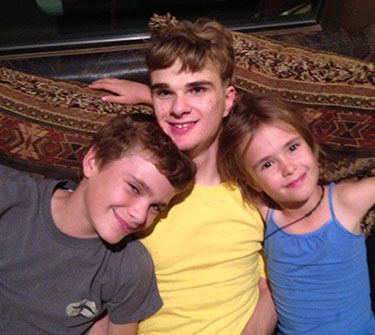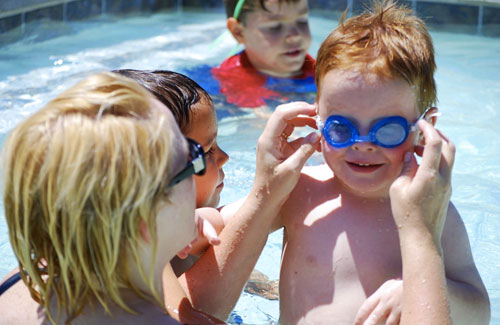Trevor Jones
by Natani Jones, as told to Iliana Clift
Now what?
 After a month in ICU and three months in a rehab facility, my son was finally home. Not having another option, my husband, riddled with guilt, went to work; I stayed home to care for Trevor—all alone, young, and inexperienced. I longed for my own mother, who lived a world away in South Africa, to come and take care of me. Trevor was alive, but just that. He could sit up with support and that was all he could do. My healthy, rambunctious baby was no more.
After a month in ICU and three months in a rehab facility, my son was finally home. Not having another option, my husband, riddled with guilt, went to work; I stayed home to care for Trevor—all alone, young, and inexperienced. I longed for my own mother, who lived a world away in South Africa, to come and take care of me. Trevor was alive, but just that. He could sit up with support and that was all he could do. My healthy, rambunctious baby was no more.
Trevor, at 14-months old, had slipped from his father’s arms and hit his head on the tile floor. All that happened next seemed as one indescribable, endless nightmare. Initially Trevor was given a 10% chance of survival; but if by some miracle he managed to pull through, the prognosis was that he would forever be in a vegetative state, wheelchair-bound, blind, silent, and kept alive with machinery. Although my heart was beating, I felt dead. It took five long days, intensifying the damage to Trevor’s brain, before the inter-cranial pressure receded enough for a ventriculostomy to be done. The neurosurgeon informed us that this procedure was by no means a “high card” and was at best the last desperate attempt to bring the ICPs down. Once he was stabilized, Trevor was taken off life support and, incredibly, was able to breathe on his own. But he wasn’t out of the woods yet. Each time he heard my voice, Trevor’s blood pressure and heart rate went through the roof, and he was put in a drug-induced, pentobarbital coma to give his brain rest.
For nine months after the accident we did conventional therapy with Trevor. We taught him to grasp, to swallow, and to sit up without help. But my soul was restless. The doctors and therapists told me not to make our home a therapy place—to let them, the experts, work with my child and hope for the best, but not much. Yet, I wanted to do more. After relentless hours of searching online I came upon The Institutes for the Achievement of Human Potential.
The week-long seminar at The Institutes in Philadelphia was held in an ice-cold auditorium packed with families seeking help for their loved ones. Like me, they had paid thousands of dollars in airfare, hotel, and registration fees to attend lectures on brain injury for 8 to 10 hours a day. I learned a lot, and for the first time I felt a glimmer of hope for Trevor. As part of the course at The Institutes, parents were required to submit a detailed history of their child. I found out once I was there that at the completion of the seminar parents were told to go home, to implement what they had learned, and to stay in touch. Occasionally, some were invited to bring their brain-injured children back for evaluation. I was one of the lucky ones—my 30-page report on Trevor was apparently detailed enough that we were chosen by The Institutes to bring Trevor in for a consultation. No other family in our group had that privilege bestowed upon them, and I felt a sense of pride that we were selected, as if my child and I were somehow extra special.
I was a mother who was willing to do whatever was necessary to make Trevor better. So I flew home, arranged for a relative to come along (as was required by The Institutes), and my husband and I took our severely brain-injured child on a cross-country trip back to Philadelphia. Once again we were subjected to more lectures training us for all kinds of injury, not just the type specific to Trevor. Meanwhile, our relative pushed Trevor from department to department for evaluation in different development areas. In the end, one of the staff members instructed us on how to implement the assigned program, provided us with all sorts of charts that periodically needed to be filled out and returned to The Institutes, and sent us home.
We soon discovered that The Institutes’ program was a tremendously intense seven-days-a-week commitment. They required that mom and dad were the only ones working with the child, and the program took every waking moment of Trevor’s day. Then, after he was in bed, one of us was busy preparing materials for the next day. The 10 hours-a-day program put a strain on our relationship and health, but we managed to somehow get everything done as assigned. Among other things, we did upwards of 80 masks a day, eight cross-patterning sessions, five categories of reading flashcards, and kept meticulous track of how many new words to introduce and what words to retire. We even brought Grandma and Grandpa from South Africa to assist with household responsibilities and for moral support. Eventually, we succeeded in getting Trevor to creep on his knees, but no matter how hard we tried, reading just did not take off. Perhaps because at that time he was functionally blind and a “reading” program was really pretend. Because we couldn’t teach our blind child to read for the 2 ½ years we were with The Institutes, Trevor was never invited to a follow-up evaluation. Instead, because I was desperate to learn about brain injury as much as possible, I attended further education lectures at The Institutes. We stayed in regular contact with our Institutes’ family advocate and diligently completed all of the assigned activities, but my optimism was waning.
Here we were with a son who, by The Institutes’ own words, had so much potential, yet they would not work with us only because he wasn’t able to read. I was frustrated and I was constantly on my knees. I just knew there had to be a way to help Trevor improve. Then one day, while searching online, I stumbled upon NACD’s website. While investigating, I discovered that Robert J. Doman, Jr.’s father and uncle had created The Institutes for the Achievement of Human Potential, but aside from sharing a common last name and dealing with neurodevelopment, the two Doman organizations were and still are dramatically different in their philosophies, methodologies, and execution. I also learned that Bob had never associated with The Institutes, nor did he accept The Institutes’ approaches.
It took me some time to contact NACD, as the Institutes strongly opposed seeking guidance elsewhere; but when I finally did, I felt a renewal of confidence. Right away I was put in touch with an NACD mom who turned out to be a great support to me in those first few months of transition. I was impressed and relieved that the NACD staff facilitated contact among their clients, while The Institutes had discouraged us from discussing with other parents about our experiences with Glenn Doman’s organization.
Unlike The Institutes, where we never saw Glenn Doman, Trevor’s first NACD evaluation in the fall of 2003 was conducted by Robert J. Doman, Jr., the director and founder of NACD. Bob didn’t promise an overnight “cure;” nonetheless his calm, even voice was like a balm to my troubled soul. Since NACD branches can be found across the United States and one was near us, we didn’t have to struggle with Trevor through airports. My son was more cooperative and relaxed as opposed to how he behaved at The Institutes, which made the NACD evaluation less stressful and more productive. At that first meeting with Bob, Trevor was essentially a baby at the age of five. He made very little eye contact and had slight cognitive understanding of what was going on around him. He babbled unintentional sounds, which we liked to think resembled “mom” and “dad,” clapped his little hands, banged his head repeatedly against the crib, and walked very unsteadily.
Gradually, with the implementation of the very realistic, doable, and individualized NACD program, Trevor’s coordination improved and his gate stabilized. As Trevor’s brain began to get organized, his vision also increased, despite the injury on the occipital lobe (which should have left him permanently blind). Trevor now sees, listens, and understands well and doesn’t give up easily when working on something difficult, like a new sound or a new word. He rides a tricycle at breakneck speeds, runs easily, and walks two miles at a time without tiring. His language grew from a few sounds to now four-word sentences. He is communicating his needs verbally, and conversations are now a realistic goal. This may not seem like much progress, until you look at his MRI—the black, fluid-filled spaces in his brain are so pervasive that where Trevor is today is truly a miracle. Before we started with NACD, the doctors recommended that we put Trevor in a home, to give up on him, because there would never be any functionality to his life. NACD not only gave us hope for something entirely different, it has delivered on the promise that allchildren, regardless of their condition or diagnosis, can accomplish more—if they are provided with the opportunity.
From the time of the initial communication with NACD, it was apparent that the differences between The Institutes and NACD were significant. As opposed to The Institutes’ practice to use exactly the same activities for all their clients during the last 50 years, our NACD evaluators draw from over 3000 techniques to adjust Trevor’s highly individualized program as needed, rejecting procedures that prove to be ineffective with Trevor and adding new methods in order to address his specific issues. Unlike the complicated activities assigned to us by The Institutes, each NACD program piece is simple to implement. The Institutes did not allow us to seek outside help with program; NACD encourages us to do it.
Being able to accept volunteers or hire helpers for Trevor’s program, as well as communicating closely with the evaluators about the smallest details of the program, has allowed us to have a more normal and fulfilling family life. Compared to the Institutes’ rigid and demanding schedule, the NACD program has been manageable to fit into our family dynamics. Our evaluators are careful to consult with us regarding the time we are able to dedicate to working with Trevor and recognize our desire to parent the rest of our children. All these factors have been vital in ensuring that progress for Trevor happens much quicker than anything we experienced while following The Institutes’ program. Amazingly, even 13 years post brain injury, big changes still continue to take place. For instance, Trevor’s language abilities have recently increased exponentially, quicker than at any other time thus far. In the last three months, Trevor has learned to pronounce /k/, /g/, and /w/ correctly and is diligently working on the /l/ sound. The NACD activities address Trevor’s specific brain damage and changed him from agitated and awkward to calm and happy, without an ounce of aggression—all devoid of drugs. He loves doing his NACD program; he is the happiest when he is actively engaged in learning and growing; and when Trevor is happy, we are all happy.
I am also very happy with the effect of the NACD program on my other two children, Troy and Ruby. Because her auditory processing is at 8 and her visual processing is at 10, six-year-old Ruby is like a miniature adult—clever, articulate, and capable of accomplishing tasks that a much older child would find challenging. She reads chapter books with impressive comprehension and competently does 3rd grade math. She is also great at working with Trevor, completing program with him, more skillfully and effectively than some adults. Troy is accelerated as well. His auditory processing is at 11 and visually he is processing at 13, which is reflected in his behavior and academics. At 11-years old, he is doing 8th grade math and reading at post-high school level. Recently we lost our helper, and implementing the NACD program in its entirety became a problem—until our NACD evaluator recommended that I train the younger children to do program with Trevor. So, for example, I would work with Troy while Ruby does some program activities with Trevor; then they switch and I work with Ruby while Troy does program with Trevor. When it is my turn with Trevor, Troy and Ruby do independent work, such as reading or listening to a recorded book. Although doing program in this way rarely leads to fulfilling 100% of Troy and Ruby’s assigned activities, they have not lost ground. In fact, just the opposite has occurred: in the three months that we’ve done this, Troy jumped forward a whole year academically!
It has definitely been a leap of faith to homeschool all three kids, but with the support of NACD we are doing a marvelous job indeed. After learning so much and seeing what NACD has done and continues to do for my brain-injured child, I couldn’t in good conscience send Ruby and Troy to a school. Their individualized NACD programs are helping them grow and learn at just the right pace. Troy and Ruby are proof that, as Bob says, “Under the direction of their parents, and with the assistance of NACD, typical children can become exceptional.” I am incredibly excited about what they will achieve next, and I am at peace knowing that working with my children is the most important job in the world; with each of them I am doing the right thing at the right time.
Brain injury is tragic and a hefty a price to pay for the knowledge I have gained about the human brain and child development. But sweet things have come from the pain and suffering. I am incredibly grateful that NACD is with me every step of the way as I continue to be an active participant in all my children’s future.



